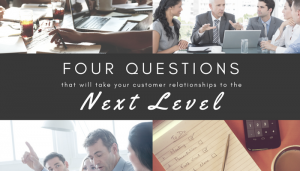By Lori Berry
We all have vendors, and if we are lucky enough we have partners. The difference: the partner truly cares about a mutually-rewarding relationship, where a vendor is single-minded in their pursuit of the next deal.
So how do you ensure your customers see you as a partner, and not just a vendor? It sounds simple, but to take your customer relationships to the next level you have to ask the right questions and more importantly listen to their answers!
Our friends at HTG recently introduced a tool that is transforming the way we do reviews with our partners. It is a simple exercise called Four Helpful Lists, and if used correctly it can turn a boring QBR or annual review into a game changer. (Four Helpful Lists is a part of the Strat-Op Process that comes from the Patterson Group.)
The Purpose
The reason for doing this is to deepen customer relationships, but it is also a safe way to find opportunities to provide value outside of the day-to-day expectations of the customer.
The Goal
You should leave this exercise with a good picture of your partnerships’ best attributes and ways to improve on both sides of the relationship.
The Questions
What is Right?
Asking customers what is right with their business or your relationship is a great way to get them comfortable with the exercise and in the rhythm of providing feedback. Have them throw out as many things that are right as possible and drain them of those thoughts before moving on.
What is Wrong?
These are the things that aren’t working either in their business or in the relationship or are risks to the business.
What is Missing?
Things that are missing should be fairly simple to identify. These items can sometimes be processes, training, resources or boundaries.
What is Confused?
You’ll know it should fall into what’s confused if you can phrase it as a question. Having it phrased as a question will also help narrow down what is confused. For example instead of saying that the shared email inbox is confusing, you would ask: How quickly should emails in a shared inbox be responded to? or Who is allowed to respond to emails in a shared inbox? That ensures you are capturing specific confusing elements.
The Process
You need at least an hour of undivided attention, and you’ll start by asking the group you’ve gathered to identify what is right. After you have a good list, open it up to the rest of the questions. The final column is core issues. You should set aside the last 10 – 15 minutes of the session to identify two to three core issues from all the lists. These are usually large or encompassing issues that were common threads throughout the discussion.
Best Practices
Here are a few other best practices:
- Invite as many stakeholders as possible to the meeting. The more perspectives the better.
- What one person thinks is a right, could be wrong to somebody else. Put them in both columns. An example of something that could easily make it into multiple columns:
- What is right: a skilled, knowledgeable, tenured operations team member
- What is wrong: knowledge concentrated with one person
- What is missing: documentation or a backup for the knowledgeable team member
- Ask for laptops and cell phones to be put away to keep their attention.
- Embrace the silence! Give people the opportunity to think. Sometimes the best bullet points come after the person has wrestled with whether they should say anything or not.
- Do not try to solve. The goal is to get as much perspective up on the board without proposing solutions.
- Have two people on your team be present. One will need to facilitate the discussion and keep folks on track. The facilitator can also record all of the discussion in the lists, or the second person can do it. The other person should also participate in the discussion and lend their perspective on what is right, wrong, missing or confused.
Finally, the key to making this exercise successful is taking all of the perspective from the four lists plus the core issues and agreeing on an action plan. This is not just up to you to do, so make sure to keep your customer engaged through the process and don’t drop the ball on the follow-up.
If you are interested to see the four helpful lists activity in action, we’d love to take your team through it with GreatAmerica.
Read the full story here – 4 Questions to Take Your Customer Relationships to the Next Level




